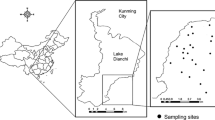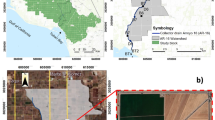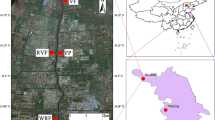Abstract
Contamination of groundwater with nitrate (NO3) derived from agricultural activity is serious problem in many countries worldwide. We investigated the annual (growing and non-growing seasons) behavior of NO3–N in the soil pore water of cropped Andosols and Gray lowland soils under eight crop groups (Type A: paddy rice, Type B: winter crops, Type C: vegetables 1, Type D: vegetables 2, Type E: vegetables and forages, Type F: legume crops, Type G: orchard, and Type H: grass). In the vegetable group (Type C) and the orchard group (Type G), which required large amounts of fertilizer and frequent top-dressing, NO3–N concentrations in the soil pore water were extremely high. In these agricultural lands, it was clear that the inorganic nitrogen produced by nitrification in surface soil was dominantly discharged from a depth of 90 cm in July to September. The descending order of the amount of discharge of NO3–N (N-discharge) was Type C > G > D > E > F > B > H > A for the Andosol, and Type G > C > F > D > E > B > H > A for the Gray lowland soil. If fertilization of the vegetables and orchard was performed based on the standard application amount, the annual average NO3–N concentration at a depth of 90 cm exceeds 10 mg L−1. To reduce the risk of groundwater contamination by NO3–N, we calculated the annual cumulative water flux density and annual cumulative NO3–N flux density. We examined the calculated fertilizer amount and proposed reduced fertilizer application amounts so that the annual average concentration of NO3–N in soil pore water would not exceed 10 mg L−1. The standard application amount of nitrogen fertilizer for vegetables should be reduced by 65.8 and 30.8 kg ha−1 in the Andosol and the Gray lowland soil, respectively. We also proposed that the standard application amount of nitrogen fertilizer be reduced by 59.9 and 40.7 kg ha−1 in Andosol orchards and Gray lowland soil orchards, respectively.












Similar content being viewed by others
References
Anase M, Yasutomi R, Tada A (1992) Agricultural land engineering, Buneido, Tokyo (In Japanese), p 37 and p 217
Endo A, Mishima S, Kohyama K (2009) Modeling nitrate leaching on a cropped Andosol. Nutr Cycl Agroecosyst 85:41–61
Freundlich HMF (1906) Über die adsorption in läsungen. Z Phys Chem 57:385–470
Hill D (1984) Diffusion coefficient of nitrate, chloride, sulphate and water in cracked and uncracked chalk. J Soil Sci 35:27–33
Imai H, Okajima H (1980) Studies on the nutrient retention power of soils (III): nitrate Adsorption. Jpn. J Soil Sci Plant Nutr 51(2):102–106
Itahashi E, Takano K, Yamamoto S et al (2006) Soil management technique. Okayama prefectural agriculture experiment station, Okayama Prefecture, Akaiwa, pp 35–36
Kubota T, Kobayashi H (2000) A simulation of nitrogen flow and runoff model for rural area based on spatial distribution patterns of cropping types. Assoc Rural Plan 2:229–234
Kunimatsu T, Muraoka K (1989) Model analysis on the river contamination. Gihoudou-shuppan, Tokyo (In Japanese), p 55
Langmuir I (1918) The adsorption of gases on plane surface of glass, mica and platinum. J Am Chem Soc 40:1361–1402
Maeda M, Ihara H, Ota T (2008) Deep-soil adsorption of nitrate in a Japanese Andisol in response to different nitrogen sources. Soii Sci Soc Am J 72:702–710
Miki N, Asaka D, Hashimoto H (2000) Acceptable level of residual nitrate in the soil profile for classifying nitrate leaching potential in agricultural soils in Hokkaido. Jpn J Soil Sci Plant Nutr 71(3):396–399
Millington RJ, Quirk JM (1961) Permeability of porous solids. Trans Faraday Soc 57:1200–1207
Ministry of the Environment (1997) Environmental Quality Standards (EQS) for groundwater pollution. URL: http://www.env.go.jp/en/water/gw/gwp.html
Mishima S, Matsumori O, Inoue T (2004) Construction of the database for estimation of nitrogen flow and nitrogen balance in districts. Jpn J Soil Sci Plant Nutr 75(2):275–282
Ozaki Y (1993) Dynamic phase and control of fertilizer component in the farmland (1). Agric Hortic 68:539–543
PDE solutions Inc. (2008) Technical descriptions of FlexPDE 5.0 User guide, pp 1–116
Ren T, Kluitenberg GJ, Horton R (2000) Determining soil water flux and pore water velocity by a heat pulse technique. Soil Sci Soc Am J 64:552–560
Šimůnek J, van Genuchten MTH (2005) The HYDRUS-1D software package for simulating the one-dimensional movement of water, heat, and multiple solutions in variably-saturated media, Version 3.0. University of California Riverside, California, p 39
Suzuki Y (1996) Green soybean. In: Suzuki Y (ed) Basic knowledge of the vegetable cultivation. Rural Culture Association, Tokyo, p 178
Tabuchi T (1985) Behavior of the nutrient salts in Agricultural land. J Water Waste 27:346–351
Tabuchi T, Takamura Y (1985) Nitrogen and phosphate discharge from water catchment area. University of Tokyo Press, Tokyo, pp 1–226
Takeda I, Kunimatsu T, Kobayashi S, Maruyama T (1991) Studies on pollution loadings from a paddy field area (II). Pollutants balance of a paddy field area and its loadings in the water system. J. Jpn Soc Irri Drain Reclam Eng 153:63–72
Takeuchi M (1997a) Nitrate and phosphate outflow from arable land. Jpn J Soil Sci Plant Nutr 68(6):708–715
Takeuchi M (1997b) Nitrogen budgets in agricultural field in relation to their characteristics in the water purification. Bull Jpn Soc Fish Oceanogr 61:187–189
Tani M, Okuten T, Koike M, Kuramochi K, Kondo R (2004) Nitrate adsorption in some Andosols developed under different moisture condition. Soil Sci Plant Nutr 50(3):439–446
Tochigi Prefecture (1992) Soil fertilization standard. Utsunomiya
Tochigi Prefecture (ed) (2000) Research results of environmental technology division, In: Research material for Tochigi Pref Agric Exper St Tochigi Prefecture, Utsunomiya, pp. 62–64
Tochigi Prefecture (ed) (2001) Research results of environmental technology division, In: Research material for Tochigi Pref Agric Exper St Tochigi Prefecture, Utsunomiya, pp. 64–70
van Genuchten MTH (1980) A closed-form equation for predicting the hydraulic conductivity of unsaturated soils. Soil Sci Soc Am J 44:892–898
Worldwatch Institute (2001) State of the world 2001. W. W. Norton & Company, New York, pp 22–216
Yamazaki F (1992) Paddy field engineering. Irrigation Engineering and Management Program, Asian Institute of Technology, Bangkok, pp 1–425
Acknowledgments
This research was partially supported by the Grants-in-Aid for Scientific Research (Young Scientists (B)) 22780224.
Author information
Authors and Affiliations
Corresponding author
Rights and permissions
About this article
Cite this article
Endo, A., Mishima, SI. & Kohyama, K. Nitrate percolation and discharge in cropped Andosols and Gray lowland soils of Japan. Nutr Cycl Agroecosyst 95, 1–21 (2013). https://doi.org/10.1007/s10705-012-9544-7
Received:
Accepted:
Published:
Issue Date:
DOI: https://doi.org/10.1007/s10705-012-9544-7




